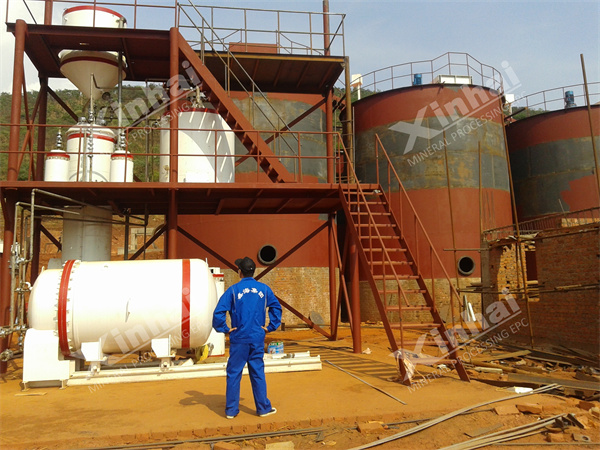Cyanide gold tailings, the residual materials left after the extraction of gold from ore using cyanidation processes, pose significant environmental and safety challenges due to their toxic nature and potential for environmental contamination. Understanding the main components of cyanide gold tailings and implementing effective treatment methods is essential for mitigating environmental risks and ensuring responsible mining practices. This article provides a comprehensive guide to the main components and treatment methods of cyanide gold tailings, covering their characteristics, environmental impacts, and various treatment approaches.

Cyanide gold tailings typically consist of several key components, each contributing to their unique characteristics and environmental behavior:
1. Cyanide Compounds: Cyanide compounds are the primary toxic constituents of cyanide gold tailings. These compounds, such as sodium cyanide (NaCN) or potassium cyanide (KCN), are used in the gold extraction process to dissolve gold from ore. However, cyanide is highly toxic to humans and wildlife, posing significant environmental risks if released into the environment.
2. Heavy Metals: In addition to cyanide, cyanide gold tailings often contain elevated concentrations of heavy metals, including arsenic, lead, mercury, and cadmium. These metals may originate from the ore body itself or from the cyanide leaching process, where they are mobilized and co-dissolved with gold. Heavy metals pose serious health and environmental risks due to their persistence, bioaccumulation, and toxicity.
3. Solids and Suspended Solids: Cyanide gold tailings typically contain solid particles and suspended solids, including ore fragments, slimes, and precipitates formed during the gold extraction process. These solids can impact water quality, sedimentation rates, and aquatic ecosystems if not properly managed.
4. pH and Alkalinity: The pH and alkalinity of cyanide gold tailings play a crucial role in determining their environmental behavior and toxicity. Cyanide is most toxic under alkaline conditions (pH > 9), where it exists predominantly in the form of free cyanide (CN-), which is highly bioavailable and toxic to aquatic organisms.
1. Cyanide Destruction
- Alkaline Chlorination: Alkaline chlorination involves the addition of sodium hypochlorite (bleach) or chlorine gas to cyanide-containing tailings under alkaline conditions (pH > 10). This process oxidizes cyanide to less toxic compounds, such as cyanate (OCN-) or nitrogen gas (N2), which are less harmful to the environment.
- Acidification-Volatilization-Absorption (AVA): The AVA process involves acidifying cyanide-containing tailings with sulfuric acid (H2SO4) to convert cyanide to hydrogen cyanide (HCN) gas, which is then stripped and absorbed using an alkaline scrubbing solution. This method is effective for treating cyanide-containing effluents and reducing cyanide concentrations to below regulatory limits.
2. Heavy Metal Remediation
- Precipitation and Coagulation: Heavy metals in cyanide gold tailings can be removed through precipitation and coagulation processes. Chemicals such as lime (CaO) or calcium hydroxide (Ca(OH)2) are added to raise the pH and promote the formation of metal hydroxide precipitates, which can then be removed through sedimentation or filtration.
- Ion Exchange: Ion exchange involves the use of ion exchange resins or membranes to selectively remove heavy metals from cyanide gold tailings. The resin or membrane exchanges metal ions in the tailings solution with ions immobilized on the exchange medium, effectively reducing metal concentrations in the effluent.
3. Solid-Liquid Separation
- Thickening and Filtration: Solid-liquid separation techniques, such as thickening and filtration, are used to separate solids from liquid phases in cyanide gold tailings. Thickening involves the settling and compaction of solids to increase the concentration of solids in the slurry, while filtration uses porous media to remove suspended solids from the liquid phase.
- Centrifugation: Centrifugation utilizes centrifugal force to separate solids and liquids in cyanide gold tailings. By spinning the tailings slurry at high speeds, centrifugal force causes heavier solids to migrate towards the outer edge of the centrifuge, where they can be collected and removed.
4. Neutralization and pH Adjustment
- Acid Mine Drainage (AMD) Treatment: Cyanide gold tailings with acidic pH levels can generate acid mine drainage (AMD), which can be highly corrosive and toxic to aquatic life. Neutralization techniques, such as limestone (CaCO3) or lime (CaO) addition, can be employed to raise the pH and mitigate the effects of AMD.
- pH Adjustment: pH adjustment involves the addition of alkaline reagents, such as lime (CaO) or sodium hydroxide (NaOH), to cyanide gold tailings to maintain neutral or slightly alkaline pH levels. This helps stabilize cyanide compounds and reduce their toxicity to aquatic organisms.